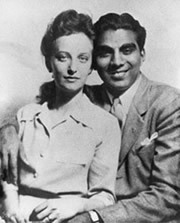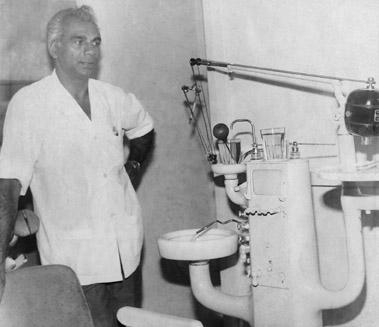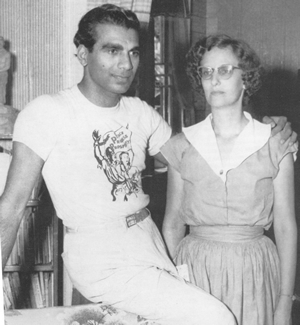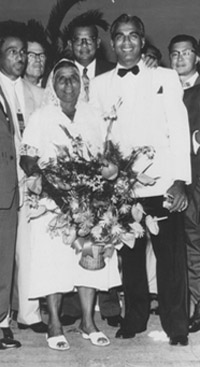Biography of Dr. Cheddi Jagan
 Growing Up
Growing Up

Cheddi Jagan was born on March 22, 1918 on a sugar plantation in Port Mourant, Berbice, the son of indentured sugar workers. His parents Bachaoni (mother) and Jagan (father) had arrived in the then British Guiana as young infants with their mothers from the district of Basti in Uttar Pradesh, India. Both his grandmothers came as indentured immigrants in 1901 and were "bound" by five year contracts to different sugar plantations in the county of Berbice. Life was very hard and both his parents had to start working in the canefields at a young age to supplement the family income.
His mother never went to school, but his father was a bit more fortunate, attending school for three years! Because his father worked very hard, he earned the reputation of being the best canecutter and was promoted to "driver." But still his pay was very small and because he was non-white there was no further avenue of promotion. He thus saw the need for formal education, and made sure that his son, Cheddi Jagan attended school.

Dr. Jagan's father, Jagan
Cheddi Jagan attended primary school and two years of secondary school in his area. At the age of fifteen his father decided to send him to Queen’s College, a government secondary school in the capital city of Georgetown, about one hundred miles away. There he boarded with three families.
In Georgetown, Cheddi found life very different from life at home where poverty had been intense and he often had to stay home from school to work in the rice fields and to cut and fetch canes. He also helped his mother keep a kitchen garden and to sell produce from it. His mother allowed him to keep a part of the proceeds for his share of the work. Cheddi Jagan wrote that he learnt the elements of finance from his mother and acquired any of his leadership qualities from his father, who was bold and flamboyant.
Trying to find a job after graduating high school, became almost impossible. The civil service was closed, to be a school teacher you had to become a Christian, something that his Hindu parents would have none of, and his father could not bear the thought of him working on the plantation. Finally his father decided to send him to the United States to study dentistry at Howard University in Washington, D.C.
 7 years in the USA
7 years in the USA

Cheddi Jagan at age
18 in the USA
Cheddi Jagan left for the United States in September 1936 with two friends and returned to British Guiana in October 1943. He lived in Washington, D.C for two years and attended Howard University, taking a pre-dental course, worked two summers in New York and spent the last five years in Chicago, Illinois at Northwestern University.
Cheddi Jagan was a dedicated student and his hard work earned him a free tuition scholarship for his second year at Howard and in 1938 entry into Northwestern University for a four year dental program.
But he was not satisfied to become only a dentist, he wanted to find to find out more about things going on in the world and enrolled in classes in social sciences. When he graduated from Northwestern University in 1942 with his degree in Dental Surgery (DDS), he also received his Bachelor of Sciences (B.Sc.) degree.

Janet Rosenberg age 21
Because his parents could not afford to support him financially, Cheddi Jagan had to work while attending school. He had many jobs – tailor (he had "picked" up at home from a friend) in a hock shop; salesperson selling patent medicines; dishwasher; delivering evening newspapers; presser in a laundry and an elevator operator.
On August 5, 1943 he married Janet Rosenberg, whom he had met only six months before, at a simple ceremony at the Chicago City Hall without the consent of parents on both sides. Their only wedding photo was taken in a 25 cent photo booth that shot automatic photos.
In October 1943, he returned home. His wife Janet, arrived in British Guiana just before Christmas of 1943.
 Getting into Stride
Getting into Stride
 Cheddi Jagan at work in his dental surgery.
Cheddi Jagan at work in his dental surgery.
Cheddi Jagan's first task was to establish a practice in Georgetown, the Capital. His wife Janet worked with him as the hygienist and office assistant. His fees were low as he did not want to exploit his patients but this led him into a public battle with the Dental Association for a principle he believed in. He brought four of his brothers and one sister to live with them, so that they could further their education.
Although he liked his profession, at the same time he longed to identify himself with something more meaningful. In those days, there were no political parties. The planter class dominated the Legislative Council and though some union leaders such as Hubert Nathaniel Critchlow, who formed the BGLU in 1922, spoke in the legislative Council on behalf of workers, they had no mass political organisation. In existence then were the League of Coloured People and the British Guiana East Indian Association.
The LCP did not interest him much since they opposed adult suffrage. The BGIEA supported constitutional changes and universal adult suffrage but was unsympathetic to the plight of the working man.

The dental surgery became a hive of activities and through it he made many important contact, many patients being ordinary rural and urban workers.
Cheddi’s name began to spread in the sugar belt –coming from a sugar estate and as well a doctor who listened to ordinary people. On many occasions he would be invited by workers to speak and advise them on industrial matters in various parts of the sugar belt. Due to his increased contacts with workers, he became involved in the two trade unions in the sugar industry, one of them being the ManPower Citizen’s Association.
In 1945 he became treasurer of that union, but was removed after a year when he objected to the glaring reluctance of the union to defend the interests of the sugar workers. It was, he discovered, a company union.
Those were the days when many things were happening. The Royal Commission on The West Indies headed by Lord Moyne had published its report, which horrified many as it related in concrete terms the miserable conditions of the workers and farmers. The war had created its own difficulties in Guyana and the region. These difficulties had stirred widespread debate in which Cheddi and his wife Janet, took an active part.
They used to take part in discussions over a wide range of subjects at the Carneige (now National) Library. An important event in that year was the convening in Georgetown of West Indian Conference attended by such leaders as Grantley Adams of Barbados, Norman Manley and Richard Hart of Jamaica, Albert Gomes of Trinidad and H.N. Critchlow of Guyana. The Labour Party had just won the elections in England and many were openly talking of socialism.
In 1946, H.J.M Hubbard, an avowed Marxist who was at that time the General Secretary of the British Guiana Trades Union Council, Ashton Chase assistant secretary in the British Guiana Labour Union, Janet Jagan who was at that time in the Clerical Workers Union, along with Cheddi Jagan formed the Political Affairs Committee and established a PAC Bulletin, with Janet as the editor. The PAC was labour oriented. All four were working in trade unions. In the same year, the Women's Political and Economic Organisation headed by Janet Jagan, Winifred Gaskin and Frances Van Stafford, was formed.

In 1947 the first elections since World War II were held. There were 14 elected seats to be contested. Apart from the middle class organisations, the LCP and the BGEIA, a Labour Party was formed but this organisation was a group of individuals put together quickly and without any mass base.
Janet and Cheddi Jagan ran as independent labour candidates -Janet contested in Georgetown and Cheddi on the East Coast of Demerara. Janet lost to John Fernandes, a businessman and catholic, who invoked the bogey of anti-communism, which was then becoming a popular weapon of the plantocracy.
Cheddi fought against some well-established people such as Frank Jacobs, a lawyer, and John D'Aguiar. The latter was clearly the most powerful as he had represented the constituency for some time, was wealthy and had enormous influence. Cheddi had worked among the sugar workers for some time and was assisted by Eusi Kwayana (Sidney King) and Ram Karran who lived in the constituency. His patience and dedicated work among the workers paid off. At the end of the count, Cheddi was declared the winner.


